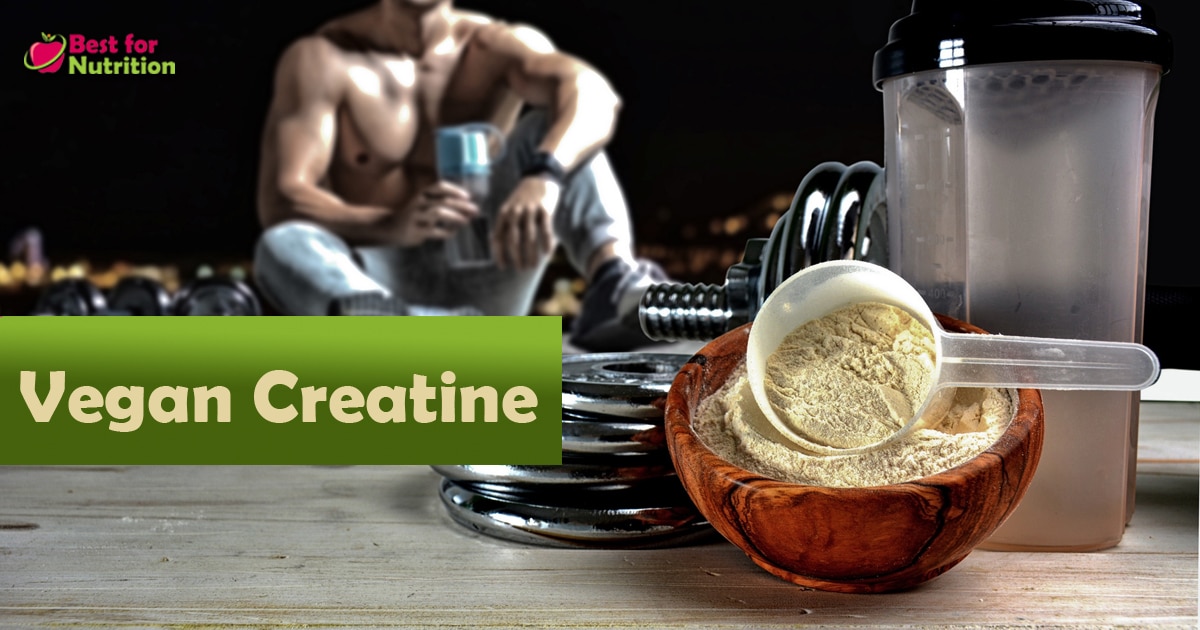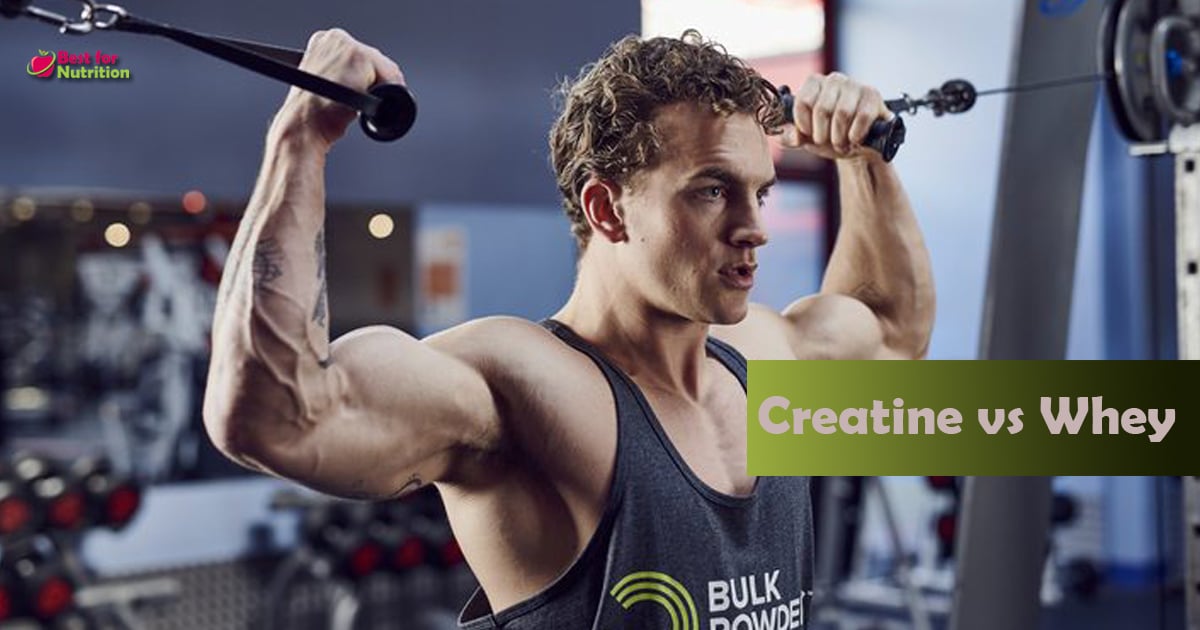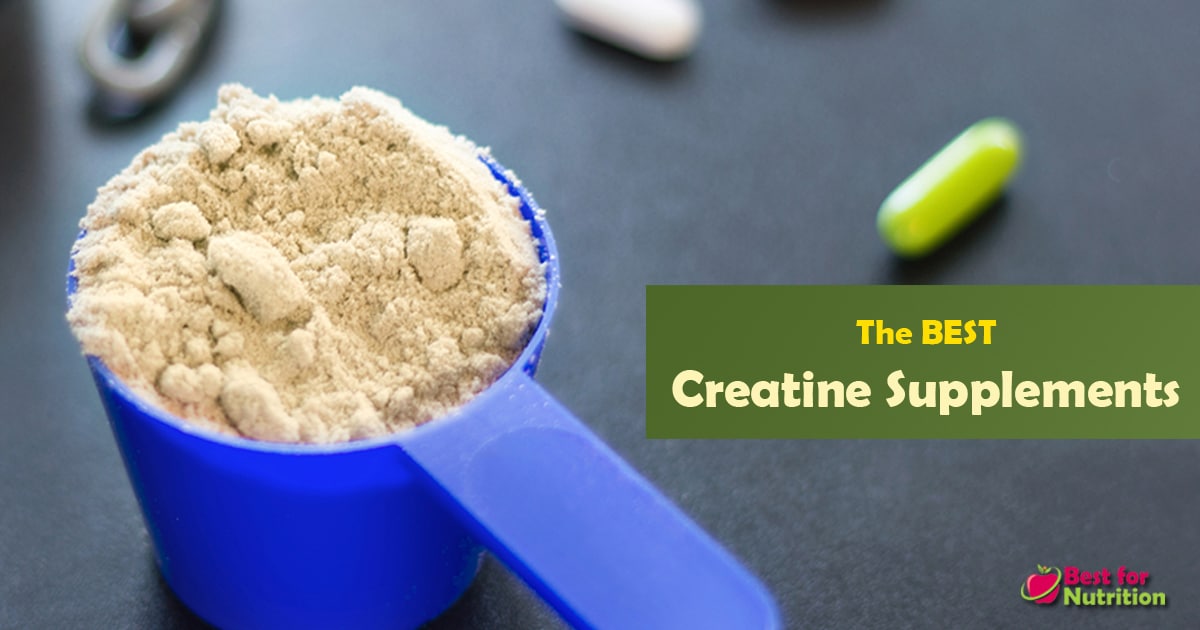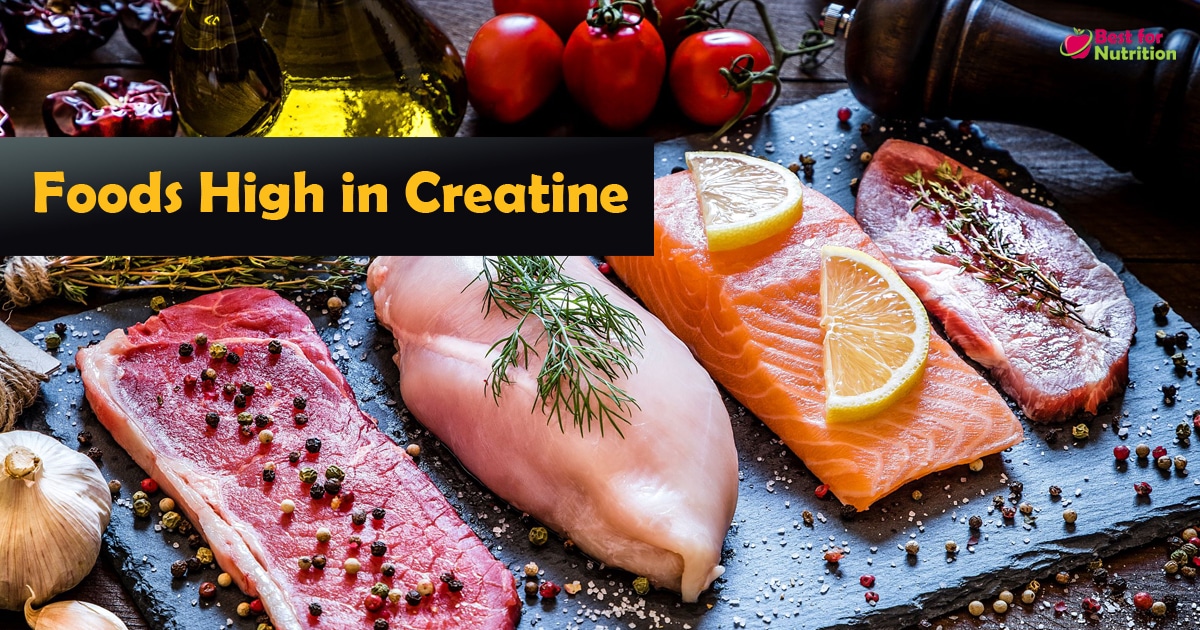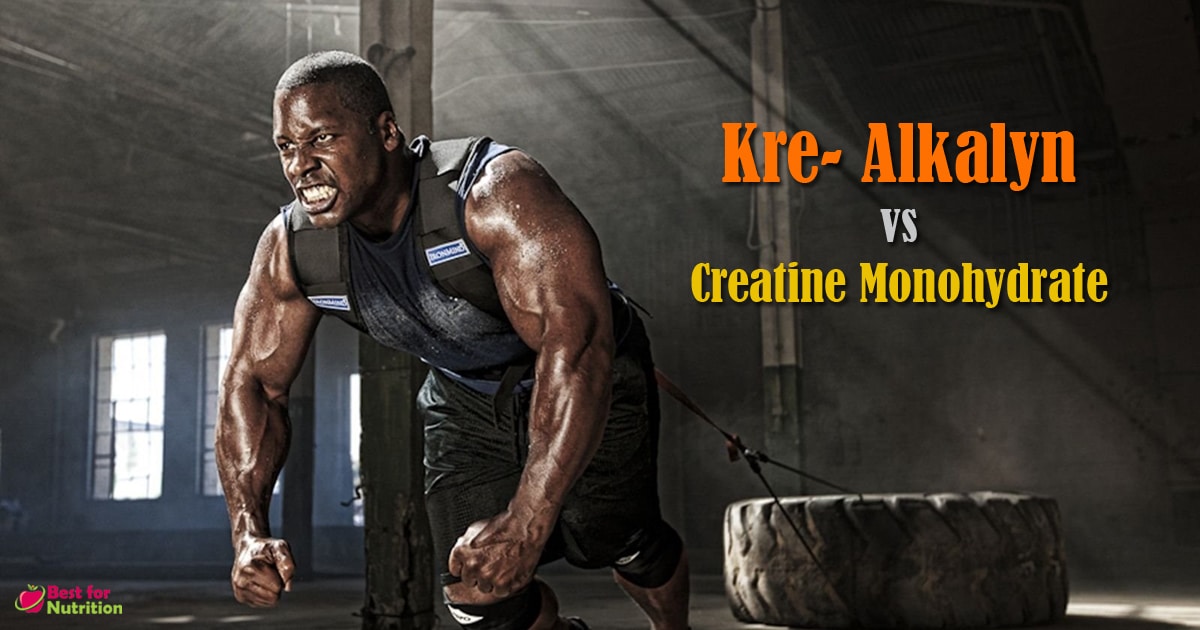Creatine is one of the world’s most tested and effective supplements that help improve your exercise performance.
Creatine primarily helps your muscles produce energy. It also increases muscle mass and helps build bigger and stronger muscles (1).
In addition to that, creatine provides certain other health benefits, such as lowering blood sugar levels, treating non-alcoholic fatty liver diseases, and certain neurological disorders (2), (3), (4).
Though there have been doubts regarding the safety of creatine intake, they have not been supported with concrete evidence.
This article will explain to you everything that is there to know about creatine.
- What is Creatine?
- How Does Creatine Work?
- The Science-Backed Benefits of Creatine
- Safety and Side effects of Creatine Supplements
- Non-Vegetarian and Vegan Creatine Food Sources
- The 10 Different Types of Creatine Supplements
- Kre-Alkalyn vs Creatine Monohydrate
- Creatine HCL vs Monohydrate: Which is Better?
- Time to Take Creatine Supplements
- Dosage Instructions for Creatine Supplements
- Creatine Loading
- Creatine for Women
- Creatine For Teenagers
- Creatine vs Whey Protein
- Creatine vs BCAA
- Creatine vs Glutamine
- Creatine vs Pre-workout Supplements
- Creatine Pills vs Powder
- Frequently Asked Questions
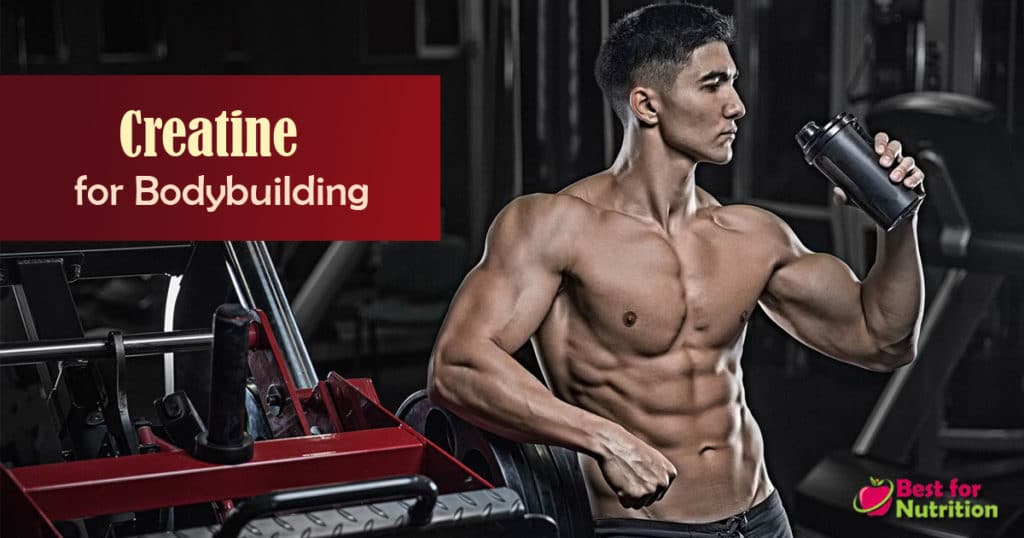
What is Creatine?
Creatine is an organic compound that is naturally synthesized in the body from the three amino acids: arginine, glycine, and methionine (5). Creatine can also be obtained from food such as meat and seafood or taken as a supplement (6).
Even though the body makes enough creatine for your everyday activities, athletes and bodybuilders may require more creatine that can boost their performance (7).
Creatine helps produce energy that can optimize your workouts. It also increases lean muscle mass, muscle strength, and enhances muscle recovery (8).
Many factors affect the creatine store of your body (9). These include creatine rich foods, exercise, amount of muscle mass, and levels of hormones like testosterone and IGF-1 which boost protein synthesis (10).
Summary: Creatine is a natural substance produced in your body that enhances and improves the strength and volume of the muscles.
How Does Creatine Work?
About 95% of the creatine present in the body is stored in the muscles in the form of phosphocreatine. The other 5% is found in the brain, kidneys, and liver (11).
So when you take creatine supplements or eat creatine-rich food, you increase your stores of phosphocreatine (12). This is a form of stored energy that helps your body produce high-energy molecules called ATP. Often known as the ‘energy currency’ of the body, more ATP can help you perform better.
The ATP breaks down to produce energy during exercise. This limits your ability to perform at maximum intensity continuously. Creatine supplementation allows you to replenish ATP, giving your muscle cells the capacity to produce more energy (13),(14).
The more is your creatine level, the more energy your muscle cells can produce during high-intensity exercise (15).
In fact, this is the primary mechanism behind the performance-enhancing effect of creatine.
Summary: Creatine increases the phosphocreatine present in muscles that help replenish ATP supply in your body. This produces energy during exercise and helps you perform at your maximum.
The Science-Backed Benefits of Creatine
Creatine does not only improve performance but also overall health among bodybuilders and athletes. It is the key energy source for heavy lifting and high-intensity exercise.
Let’s have a look at some of the science-based benefits of creatine:
Provides Extra Energy by Increasing ATP Synthesis
Supplementing with creatine increases the phosphocreatine store that helps boost the level of ATP (adenosine triphosphate) molecule, used for all basic life functions (16),(17).
Creatine supplementation replenishes them and offers a quick burst of energy that enables you to perform at maximum intensity (18). Creatine also increases strength and power (19).
Increases Cell-hydration
Creatine causes cell volumization, which is increasing the water content of your muscles.
This makes your muscles look big. It is a crucial mechanism in muscle growth (20), (21).
Boosts your Endurance
Creatine significantly improves your capacity to workout thereby enabling you to put on more time and effort on your training session.
Unlike most other supplements, creatine benefits you regardless of your fitness level.
One study observed that creatine improves high-intensity exercise performance by 15% (22). However, endurance exercises depend less on rapid ATP regeneration and therefore show lesser improvement with creatine as compared to high-intensity exercise (23),(24).
Aids in Muscle Recovery
Creatine aids in muscle recovery by boosting muscle protein synthesis after a workout session. By lowering muscle damage and accelerating muscle recovery, creatine reduces post-workout soreness.
A 2004 study, observed that creatine had the ability to reduce inflammation and muscle soreness following a 30 km race (25).
Raises Anabolic Hormones
Creatine promotes the release of anabolic hormones such as IGF-1 and HGH, which are involved in muscle synthesis (26), (27). Pituitary glands produce HGH and stimulate the liver in producing IGF-1 (28).
Both these hormones have an inverse relation with the body fat which means if IGF-1 and HGH are less in the body, the more body fat will accumulate. Viceversa will ensure less fat and leaner muscle.
Increase Lean Muscle Mass
Creatine can alter numerous pathways that boost new muscle growth. One such example is it’s aiding the formation of proteins that help create new muscle fibers (29).
Supplementation of creatine combined with resistance training decreases the level of myostatin (30). It is a molecule that is responsible for stunting the growth of muscles. With a reduction in the myostatin level, the muscle-building process becomes faster (31).
Creatine has also shown to enhance satellite cell number and myonuclei concentrations in the skeletal muscles when combined with regular strength training. This boosts muscle growth as well (32).
Creatine for the Brain
Creatine improves cognitive processing and neurological performance. It is most evident in vegan and vegetarians due to their lower creatine levels (33), (34).
A number of studies in animals have showcased its potential in the treatment of neurological diseases such as Alzheimer’s, Ischemic Stroke, spinal cord injury, and many more (35). Creatine has also shown to display anticonvulsant effects in epilepsy seizures (36).
Creatine may Treat Depression
Creatine helps relieve symptoms related to depression (37). A 2015 study revealed the therapeutic effect of creatine in females who had lower phosphocreatine concentration and were taking medicines for depression (38).
Other Health Benefits
Apart from the above-mentioned benefits, creatine also helps lower blood sugar levels, improves muscle functions especially in older adults thereby increasing their quality of life.
Research indicates that creatine can also help prevent non-alcoholic fatty-liver disease (NAFLD) (39). It also checks the negative health effects associated with high-fat intakes such as inflammation and oxidative stress (40), (41).
Summary: Creatine provides the energy to your muscles and supports metabolic functions that increase your muscle growth.
Safety and Side effects of Creatine Supplements
Several studies have supported that creatine is safe to consume both short and long term (67).
The International Society of Sports Nutrition (ISSN) has confirmed that 30 grams of creatine supplement, consumed daily for 5 years is safe and well-tolerated by people who do not have any ailments (68).
In rare cases, gastrointestinal problems such as nausea, vomiting, and diarrhea have been noted. Some have reported bloating and water retention in the muscles.
Creatine is metabolized by the kidneys and in some cases, if you have an impaired kidney function or renal disease, creatine supplement may worsen the kidney function. It is always better to consult your physician before starting on it (69).
Creatine in some cases also has shown to increase dehydration and cramping, but recent research refutes these claims. Some studies confirm the opposite.
Overall, it is believed to be safe. Be sure to take the recommended dosage and consult your doctor in case you are pregnant, lactating, or have any underlying health issues.
Summary: Most research has confirmed the safety and effectiveness of creatine supplement usage in healthy individuals when taken in the recommended dosage.
Non-Vegetarian and Vegan Creatine Food Sources
A person normally needs 1-3 grams of creatine a day (42). Around half of this comes from the food you eat and the rest is synthesized by your liver from amino acids: arginine, glycine, and methionine (43).
Creatine from Non-Vegetarian Sources
Creatine is a molecule present in animal foods. Therefore, foods that are a rich source of creatine are animal protein (44), (45).
Amongst all the different types of meat that are available, bushmeat is the best source of animal creatine. They include deer, bison, or buffalo. In addition to the high creatine, they have fewer calories and saturated fat.
Their fat-free tissue is more than domestic cattle. They are followed by the farmyard meat and fish. Below is a list of creatine rich food and their amount:
- 1 kg of steak: 4.5 grams
- 1 kg of chicken: 3.4 grams
- 1 kg of herring: 4.5 grams
- 1 kg of venison: 4.5 grams
- 1 kg of tuna: 4 grams
- 1 kg of salmon: 4.5 grams
- 1 kg of pork: 5 grams
- 1 kg of Cod: 3 grams
Summary: Creatine is found naturally in muscle cells and found in high amounts in animal proteins. Red meat and fish are the highest sources of creatine.
Creatine for Vegans
Even though dairy products and vegetables are not considered good sources of creatine, they are good sources of the amino acids that help synthesize creatine in the body (46).
They are:
- Arginine and glycine: Milk, cheese, pumpkin seeds, sesame, nuts such as walnuts, almonds, pine nuts, legumes, and seaweed.
- Glycine: Spirulina, watercress, and spinach.
- Methionine: Eggs, milk, tofu, brazil nuts, ricotta cheese, and quinoa.
For vegan athletes, the restrictions are higher, as they can’t consume dairy and eggs. Therefore, in addition to the above-mentioned foods, most beneficial for them are forms of creatine that are synthesized from sarcosine and cyanamide (47), (48).
This does not contain any animal by-products and is vegan friendly.
Summary: Plant foods containing arginine, methionine, and glycine can be a great source of creatine, as the body can produce creatine with these amino acids. They can be vegan friendly and help meet the nutritional requirement.
The 10 Different Types of Creatine Supplements
Creatine supplements come in different forms. The most well-researched form is creatine monohydrate. In fact, most scientific effects of creatine have been observed while studying this form (49).
Over the years, many other forms have been formulated, claiming their superiority over the monohydrate form. However, the evidence is still lacking in that regard.
Let’s take a look at the common forms:
Creatine Monohydrate
This form of creatine has shown the most scientific effects of creatine. Creatine monohydrate has the best safety record, widely available, most effective, and has the lowest price (50).
Creatine Hydrochloride
In creatine hydrochloride (HCL), a creatine molecule is bound with hydrochloric acid. This is believed to enhance its solubility and the speed at which it is absorbed.
A study conducted in Nebraska, USA, confirmed its solubility 38 times better than the monohydrate form. However, published experiments do not confirm the same (51).
Creatine Ethyl Ester
Creatine ethyl ester is claimed to be much better than any other form of creatine, in terms of its muscle uptake, however, studies do not support the claim (52), (53).
Creatine Ethyl Ester Malate
Creatine ethyl ester malate is formed by adding malate to creatine ethyl ester. It is believed to have quicker absorption and better utilization, however, its confirmation awaits more studies (54).
Creatine Gluconate
This is believed to be the new best creatine formula on the market. The gluconate molecule that is attached to creatine is a fast-acting carbohydrate that leads to the transportation of creatine into the muscle cells rapidly.
However, the gluconate molecule has shown to cause an insulin spike which can be a limiting factor for many.
Kre-alkalyn or Buffered Creatine Monohydrate
Kre-alkalyn is a trademarked, pH corrected form of creatine monohydrate that has proved to solve creatine supplement related problems such as water retention, bloating, and cramping.
Liquid Creatine
Liquid creatine was formulated to make using supplements more convenient.
However, the instability of creatine in liquid form challenges the claim and doesn’t make it superior to the powdered form (55), (56), (57).
Creatine Magnesium Chelate
This is formed by binding magnesium to the creatine molecule.
Even though studies did conclude its efficiency at par with creatine monohydrate, lack of sufficient information prevents us from recommending it (58), (59).
Creatine Citrate
Creatine citrate is formed by combining creatine with citric acids.
It is believed to be more soluble in water in comparison to creatine monohydrate, however, studies are yet to prove it (60), (61).
Creatine Nitrate
Creatine nitrate is formed by binding creatine with a nitrate group (62).
Only one study published recently has indicated its solubility to be 10 times better than creatine monohydrate or buffered creatine. More studies are needed to support it (63).
Summary: To date, the best form of creatine supplement which is adequately supported with studies and conclusive data is creatine monohydrate. Even though several other forms have been formulated over the years, claiming better efficiency, sufficient data is missing.
Kre-Alkalyn vs Creatine Monohydrate
Kre-alkalyn, also known as buffered creatine is a trademarked, pH corrected, creatine monohydrate. It is believed to address all the side effects related to creatine monohydrate and neutralize them.
The different factors which make Kre-alkalyn unique are:
- Kre-alkalyn is the only product that guarantees 100% stability all the way to the muscle cells (70).
- In fact, the manufacturer’s claim that it is up to ten times more powerful than the ordinary creatine, so much so that 1.5 grams of Kre-alkalyn is as good as 10-15 grams of ordinary creatine.
- Kre-alkalyn does not require a loading phase unlike other forms of creatine, therefore much more convenient.
- Kre-alkalyn does not have side effects such as bloating, stomach aches, or cramping, unlike other forms (71).
However, Kre-alkalyn is far more expensive than creatine monohydrate, which is considered safe, convenient, and widely used. It is approximately 4 times the cost of creatine monohydrate.
Summary: Kre-alkalyn is the buffered, pH-regulated creatine monohydrate, with increased absorbability, more effectiveness, and convenience. Kre-alkalyn doesn’t have the side effects like creatine monohydrate.
Creatine HCL vs Monohydrate: Which is Better?
A common debate among creatine supplement users is whether creatine HCL is better than the more commonly used creatine monohydrate. Let’s find out who’s the winner in this one!
Creatine Monohydrate
Creatine monohydrate is a creatine supplement that is made by adding a creatine and water molecule. It resembles the natural form of creatine that your body synthesizes. It is the safest, convenient, and backed with most scientific studies than any other form of creatine supplement.
Creatine Hydrochloride
Creatine hydrochloride is formed by binding creatine with a hydrochloride molecule. It is believed to be more soluble in water than the monohydrate form that increases its bioavailability (72).
Creatine Monohydrate vs Creatine Hydrochloride
- Creatine hydrochloride is believed to be better soluble than creatine monohydrate. According to a 2010 study, creatine hydrochloride is 38 times more soluble than creatine monohydrate (73). This makes it easier on your stomach and reduces the side effects normally caused by the monohydrate form. However, more evidence is required to completely confirm this claim.
- Water retention is a major problem with all forms of creatine supplement. Bloating and weight gain is common with creatine supplements mainly during the loading phase. However, this is temporary and subsides with time. While creatine monohydrates have this problem, creatine HCL is claimed not to have them. Yet, lack of evidence can’t confirm the assumption.
- Creatine monohydrate has some minor side effects such as gastrointestinal discomfort and feeling of nausea and vomiting in some people. It is believed that creatine HCL has no adverse side effects.
- Benefits experienced by the body by consuming creatine hydrochloride and creatine monohydrate are the same. They increase strength, endurance, and build big and strong muscles. However, studies back up the claims made by creatine monohydrate, while creatine hydrochloride needs more studies in this regard. In other words, the former has a better safety record.
- Creatine monohydrate is much cheaper and more affordable than creatine hydrochloride.
- Creatine monohydrate is believed to be the purest form of creatine in the market.
Summary: Even though creatine hydrochloride is claimed to be better than creatine monohydrate in terms of solubility, lesser side effects, and more bioavailable, the later is safer, affordable, and most effective which is backed by science. Though the claims are promising, more research is required.
When is the Right Time to Take Creatine Supplements?
It is extremely important to take creatine supplements at the right time to reap its maximum benefit. It not only improves your efficiency to workout but also aids in muscle recovery post-workout.
Lets quickly go through all the options:
- Pre-workout: As a pre-workout supplement, creatine helps saturate your muscle creatine that can produce sufficient ATP to boost your performance. This is mainly seen in heavy lifting and high-intensity workouts.
- During workout: Creatine supplementation during a workout helps you be energetic and improves your endurance. It also increases your capacity for training and helps reduce muscle soreness.
- Post-workout: Post-workout creatine supplementation helps delay fatigue thereby improving performance. It helps reduce muscle soreness and supports quick recovery (74). The depleted creatine store is also replenished (75).
- Rest Days: On rest days, consuming a lower maintenance dose of creatine helps you build up creatine levels in the muscles, which is most important while undergoing the loading phase.
Summary: Creatine as a pre-workout supplement, gives you a boost of energy, as an intra-supplement increases your endurance and as a post-workout, helps in muscle recovery. Creatine consumption on rest days ensures sufficient creatine levels in the muscles.
Dosage Instructions for Creatine Supplements
Creatine is made by the liver in the body as well as obtained from creatine rich foods such as meat and fish. However, this can only lead to 60-80% of your muscle store of creatine.
Creatine supplements can help maximize your creatine store.
Creatine Loading Phase: This is normally recommended to maximize the muscle store. During this phase, a large amount of creatine is consumed in a short period of time (64). Normally, it is 20 grams of creatine taken for 5-7 days regularly. This dose can also be divided into 5-gram serving, 4 times a day.
The amount may vary depending on your weight, therefore a more efficient way to determine your daily dose for the loading phase is multiplying your weight by 0.3 grams per kg or 0.01 grams per pound.
Studies have supported this and stated that this procedure can effectively boost your creatine stores by 10-40% (65).
Maintenance Phase: Once the loading phase is done and muscles are sufficiently saturated with creatine, a lower dose of creatine is taken as a maintenance dose. It ranges from 2-10 grams daily (66).
A Different Approach: If you are not a fan of creatine loading, then you can consider taking 3 grams daily for 28 days. This dose is equally effective at saturating your muscle with creatine.
Summary: Creatine dosage consists of two phases. The first one is the loading phase, where 20 grams of creatine is consumed daily for a week or so. This is followed by a maintenance phase which is 2-10 grams daily. 3 grams daily creatine supplement for 28 days have also been effective in muscle saturation.
Creatine Loading: Dosage, Benefits, and Side Effects
Trainers recommend a creatine loading phase, which means consuming a relatively large amount of creatine in a short-period to rapidly saturate your muscles.
The creatine loading phase can increase your body creatine stores very fast, ensuring quicker results.
Dosage
During creatine loading, 20 grams is taken daily for 5-7 days, which is divided into four servings of 5 grams throughout the day.
This effectively boosts creatine stores by 10-40%. A maintenance dose of 2-10 grams can be taken thereafter (76), (77), (78).
Benefits of Creatine Loading
Below are mentioned some of the benefits of creatine loading:
- Improved performance: Saturation of your muscles with creatine during its loading phase can improve performance up to 10-20%.
- Muscle gain: Creatine loading and supplementation have consistently been tied to a significant increase in muscle mass, especially when combined with resistance training.
- Increase in muscle strength: Creatine loading has shown to increase strength and power by 5-15%.
- Prevention from sports-related injury: Creatine loading also results in less muscle tightness and reduced strains as compared to creatine-non-users.
- Better pump: Creatine loading increases cell volumization which means muscles looking fuller, more extra reps, and heavier sets. This swelling effect also triggers muscle protein synthesis, resulting in muscle gain.
Safety and Side Effects
According to the International Society of Sports Nutrition (ISSN), healthy individuals can generally tolerate about 30 grams per day for 5 years. There is no safety issue related to this (79).
However, in rare cases, the common side effects and risk factors that have been observed are weight gain, dehydration, and gastrointestinal problems. High doses of creatine may adversely affect kidneys and liver, but this won’t impact a healthy person (80).
Summary: Creatine loading is the phase of increased creatine levels. It may be associated with digestive problems, kidney problems, and weight gain. However, new evidence confirms that while some problems are temporary others are only true amongst people with earlier ailments.
Creatine for Women
Even though the exercise goals of a woman are very similar to men such as increasing strength, performance, and power, some may worry that supplementing with creatine may give them the appearance of a hulk.
However, research has shown that creatine can be as beneficial for reaching workout goals for women as it is for men. A study showed that female athletes supplementing with creatine had greater upper body strength and have shown a significant reduction in body fat after 5 weeks (81), (82).
- Energy Booster: Creatine helps produce ATP that is the basic form of energy our body requires to function.
- Performance Enhancer: The increase in energy production leads to improved performance during high-intensity exercises. The improvements range from 1-15% on average.
- Lean Muscle mass building: Creatine has shown to double your strength and lean muscle gains (83), (84). It improves muscle performance in women without significant gains in muscle volumes or weight.
- Reduces post-workout recovery: Creatine helps in post-workout recovery by reducing exercise-induced muscle damage and increased muscle protein synthesis (85).
- Helps in cognitive function: By improving the oxygen uptake in the brain, creatine supplementation helps support mental clarity. This is especially important during workouts which are mentally challenging such as complex boxing and dancing.
- Helps during pregnancy: Creatine not only positively affects the ability to exercise and perform better in women, but it also helps women during pregnancy by supporting the heightened metabolic activity. As the fetus grows, a great amount of energy is needed, which can be easily sufficed by creatine supplements (86).
- Support healthy bones: The Journal of the International Society of Sports Nutrition found that creatine supplementation helps support healthy bones and skeletal muscle mass, in women aged more than 50 (87), (88).
- Works against depressions: One of the biggest causes of depression is alterations in the regulation of brain energy stores. Supplementing with creatine improves brain bioenergetics by improving the creatine and phosphocreatine metabolism and reducing mental fatigue (89), (90).
Recommended Creatine Dosage for Women
A loading dose of 20 grams per day for 5-7 days leading to a supportive dose of 2-5 grams daily has been seen to maintain elevated levels of creatine that is sufficient for the improved performance.
Summary: Women who want to maximize their performance in the gym or athletes who want to give their best while maintaining good physical and mental health, can safely consider taking creatine supplementation.
Creatine For Teenagers
If your teenager is into sports or a fitness enthusiast, you have most likely heard of creatine supplements. Even though creatine usage is backed with science, it is still debatable whether it is the right choice for teens.
Even though The International Society for Sports Nutrition lays down rules for the use of creatine by teen athletes, pediatrics do not support them (91).
Studies conducted on high school players confirmed that creatine supplementation use was widespread among them (92). Most were encouraged by their friends while parents discouraged its use (93).
Benefits of Creatine for Teenagers
- Increases muscle mass: Creatine supplementation helps increase muscle mass by raising anabolic hormones such as IGF-1 that boosts protein synthesis, increasing cell-hydration, and improving cell signaling which aids in muscle repair and new muscle growth.
- Increases strength and performance: Studies have revealed that creatine increases strength, muscle power, peak-power during exercise, and boosts performance by increasing the fat-free mass (94), (95), (96).
- Increases endurance and stamina: By regenerating ATP (the energy molecule in your body), creatine increases stamina and endurance mainly during high-intensity exercise (97).
- Supports post-workout recovery: Creatine supplementation prevents muscle breakdown and promotes muscle synthesis, thereby reducing the injuries. It also reduces the recovery time (98).
- May aid in treating pediatric disorder: Apart from sports, creatine supplementation also has potential therapeutic properties and has been used for quite a while to treat disorders such as muscular dystrophies, traumatic brain injury (TBI), and many more diseases (99). It also has helped improve several parameters which include cognitive functioning, and behavior in teens with TBI (100).
Recommended Creatine Dosage for Teenagers
Creatine dosage is dependent on age, sex, kind of exercise, and medical conditions. Studies show that a dose of 0.3-0.8g/kg/day as a short supplementation ranging between 3-5 days is good enough for ergogenic benefits (101).
Summary: Pediatricians do not agree to creatine use in teens. However, the supplement is very popular, especially in players and gym-goers. Though side effects have not been stated, more conclusive studies need to be done to confirm the same.
Creatine vs Whey Protein
Creatine and whey are similar in some aspects and different in others. They both aid in muscle growth and are performance boosters, yet the mechanisms by which they do so are very different.
The main differences between creatine and whey are:
- Amino acids: Creatine is synthesized by the body from the three non-essential amino acids: glycine, arginine, and methionine. Whey protein contains all the nine essential amino acids that our body needs to obtain from food or supplement as it can’t be synthesized on its own (102).
- Functions: Creatine mainly works by regenerating ATP in the muscles that boost your energy (103). This increases stamina, endurance, and overall performance of your workout. Whey protein on the other hand induces a series of reactions that stimulate muscle protein synthesis resulting in increased muscle mass, decreased muscle breakdown, and increased muscle strength (104).
- Workout benefits: Creatine gives a fuller look with bulging muscles because of water retention. This also induces muscle growth. It enables longer and harder training especially during high-intensity exercise because of the energy surge. Whey in comparison supports muscle growth and fastens the recovery process.
- Timings: Even though creatine and whey supplement can be taken both before or after a workout, creatine as pre-workout and whey as post-workout works the best. Creatine gives you the spurt of energy and whey helps quicker recovery.
Summary: Creatine increases the capacity to exercise thereby increasing strength and muscle mass whereas whey does the same by increasing muscle protein synthesis.
Creatine vs BCAA
BCAAs (branched-chain amino acids) are made of three essential amino acids: leucine, isoleucine, and valine (105). These are the amino acids that the body can’t produce and needs to be obtained from your diet or supplement.
BCAA, especially leucine, speeds up muscle synthesis, and increases post-workout recovery (106), (107), (108). With very low calories, BCAAs provide the right choice if you wish to reduce without compromising on your lean muscle. It can also be used in a fasted state (109), (110).
The basic difference between Creatine and BCAA are:
- If you want lean muscle mass while cutting fat, BCAA supplementation is the right choice for you. If you want to bulk up and gain strength, creatine is the right supplement (111).
- BCAAs boost aerobic exercises such as cardio, aerobics, HIIT, athletics, and strength training whereas creatine provides you the energy burst required for heavier and longer workout sessions (112). Creatine gives effective results in sprinting, weight lifting, and pushups (113).
- BCAAs can be taken before, during, and after a workout to get maximum fuel and stay in an anabolic state that induces muscle protein synthesis (114). This speeds up muscle recovery and reduces muscle soreness. In contrast, creatine is most suitable before a workout and provides sufficient energy to boost performance (115).
- BCAA is best suited if you want to be lean and strong while creatine draws in more water into the muscles which makes them look larger and muscular (116).
BCAAs and creatine supplements can also be taken together. BCAA will provide extra protein while creatine will give the extra energy.
They together will power your workout during HIIT and boost your training volume.
Summary: Creatine and BCAA are performance-enhancing supplements, where BCAA is the protein source and creatine is the energy source. Together they can lead to increased power and endurance.
Creatine vs Glutamine
Glutamine is an amino acid that our body can produce naturally. In fact, it is the most abundant amino acid in the body and plays a crucial role in keeping your immune system strong, maintaining good intestinal health, and supporting post-workout muscle recovery (117).
Glutamine can also be obtained from animal protein. This is sufficient to meet our needs and the rest are stored whenever it is needed (118).
However, it has been observed that following a period of intense exercise and heavy lifting, athletes have shown decreased glutamine levels in the body (119). This resulted in the claim that supplementation by glutamine might be required.
Let’s quickly have a look at the basic differences between creatine and glutamine:
Amino acids
Creatine is synthesized in the body from the three amino acids: methionine, glutamine, and arginine (120). Glutamine is an amino acid that is synthesized in the body (121).
Normally both of them can be sufficiently obtained from animal protein, however, exercise and workout increase their need leading to supplement requirements.
Muscle Recovery
Both creatine and glutamine enhance muscle recovery. Glutamine supplementation increases glycogen storage in muscle and preserves muscle mass by increasing the availability of nitrogen during muscle breakdown (122).
Creatine increases muscle recovery by boosting anabolic reactions that enhance muscle growth (123).
Function
Creatine helps generate energy molecules called ATP that supply the muscle with energy by increasing the phosphocreatine store (124), (125). This provides a burst of energy that enhances anaerobic activity (126). It also benefits high-intensity interval training (HIIT) by increasing the strength and power of muscle contractions (127).
Glutamine in contrast is a fuel source for immune cells. This helps support the immune system during prolonged and intense physical exertion such as marathons, triathlons, and ultra-distance events (128), (129).
This is also applicable during high-intensity strength training workouts. Glutamine works to prevent transient inflammation and oxidative stress, thereby ensuring a healthy exercise regime without falling sick (130).
Fitness Goal
If your goal is muscle building, creatine is the one that you are looking for. However, if your goal is to develop a lean physique, then glutamine will work better.
Glutamine increases HGH (Human Growth Hormones) by nearly 400 percent. An increase in this hormone increases metabolism which leads to fat loss (131).
Can Creatine And Glutamine Taken Together?
Creatine and Glutamine can be taken together making it an ideal post-workout drink combining both the benefits. This will allow you to perform intense workouts better, speed up your muscle recovery, and restore the body’s energy stores.
Summary: Creatine provides excess energy resulting in increased stamina, power, and endurance while glutamine focuses more on the immunological benefits of the athlete. However, both creatine and glutamine help reduce post-workout soreness and aid in muscle recovery.
Creatine vs Pre-Workout Supplements
In the performance-enhancing supplement world, another battle rages between creatine and the numerous pre-workout supplements that have flooded the market. The question is: Which will give you the best results?
What are Pre-workout Supplements?
Pre-workout supplements are multi-ingredient dietary supplements that are used to enhance athletic performance. The purpose is to increase endurance, energy, and focus during a challenging workout (132), (133), (134), (135).
Although the ingredients may vary in different brands, some common ones that are mostly there are amino acids, caffeine, creatine, B-vitamins, and antioxidants. Considering the needs, some are even calorie-free.
Creatine vs Pre-workouts: The Winner!
Creatine is a standalone supplement that is used to promote strength and size while pre-workout is specially formulated to enhance the performance. It is a combination of supplements and often includes creatine as one of the ingredients.
The advantage of having a pre-workout supplement over creatine only supplement is the overall boost that it gives. While creatine boosts your energy and aids muscle building, pre-workout supplements work on the overall well being of the athlete (136), (137).
Finally, while choosing, it comes to only one important factor: what is your goal? Therefore, if you are looking for a supplement that will give you more energy, focus, endurance while working out, pre-workout supplements are the ones.
However, most of the pre-workout supplements are short-lived, especially stimulants. In comparison, you need to build up your body creatine store for a while before the effect kicks in. But, its effect is long-lasting.
Creatine can be used for extended periods without side effects while it is recommended to cycle pre-workouts to maintain their effectiveness and safety (138).
Can you Take Pre-workouts and Creatine Together?
Most pre-workout supplements already contain creatine as one of the ingredients. If you chose to take creatine as well as a pre-workout supplement, you can do that.
You will be flooded with energy that will boost you to train with higher intensity. Creatine and pre-workout do so via different mechanisms though.
Creatine stimulates your ATP regeneration while caffeine in pre-workout helps boost motivation. The vitamins present help improve mood, and amino acid beta-alanine present in the pre-workout supplement boosts the production of carnosine which improves muscle endurance.
Therefore, both of them can work together in their own way and not against each other.
Summary: Creatine boosts energy, increases the size and muscle power while pre-workout supplements are performance-enhancing powders made of many different ingredients focused mainly on your workout.
Creatine Pills vs Powder: Which is Better?
Creatine is largely obtained from the diet. However, supplementation is often needed if this is not sufficient enough. This can be in the case of vegetarian and vegan athletes, elite athletes, people who are into HIIT (high-intensity interval training), and many more.
Creatine supplements come in both powder and pill form that may often lead to confusion related to their efficiency.
Let’s look at the pros and cons of creatine pills vs creatine powder.
- Absorbability: Creatine powder has a very high absorbability in the body as compared to pills that are not so easily absorbed. The outer covering of the pills needs to be dissolved first before releasing its content.
- Convenience: Creatine pills are more convenient to transport than creatine powder.
- The convenience of mixing: Creatine powder doesn’t always blend properly compromising on the measured amount that is taken. Pills on the other hand do not have any such problems.
- Dosage: The loading phase of creatine is much easier with pills as compared to powder.
- Taste: Powder has a bitter chemical taste that when mixed with any other shake gives a bad taste, which is obviously not in the case of pills.
- Affordable: Powder is more affordable as compared to pills, which can be pretty expensive.
Either way, creatine supplements are great for energy and building muscle mass, and it totally depends upon your convenience as to which one you choose.
Summary: Although creatine pills are more convenient to travel with and easy to use, Creatine powder supplements absorb better in the body. Even though pills help you avoid the bitter taste and inconvenience of huge doses, creatine powder is easier in the pocket.
Frequently Asked Questions (FAQs)
Can You Take Creatine on a Keto Diet?
It is absolutely safe to take a creatine supplement while on a keto diet as it contains no hidden carbs. While practicing a keto-diet, take creatine just before or after a high-intensity workout.
If you take it before the workout, it will help your muscles to maximize the use of available energy. In case, you take it after the workout, creatine will help in muscle growth and repair damaged muscle tissue.
Does Creatine Cause Hair Loss?
It is very unlikely that creatine supplementation in itself will cause hair loss. However, creatine has shown to increase the level of a specific hormone called DHT (dihydrotestosterone) levels which play a role in hair loss. This is more if you are genetically predisposed to hair loss (139).
Does Creatine Break Intermittent Fasting?
Intermittent fasting is a specific eating pattern where you cycle between periods of eating and fasting. Anything that will not trigger an insulin response such as water, tea, or coffee without sugar and creamer should be fine while fasting.
Creatine can be safely taken during intermittent fasting because it is calorie-free and does not affect any insulin response.
Can I Take Creatine While Cutting?
A cutting diet is a diet practiced by the bodybuilders and fitness enthusiasts in order to cut body fat while maintaining muscle mass. They often alter between a loading phase and a cutting phase.
The loading phase means the intake of high calories in the form of carbs, protein, and fats. This is believed to boost muscle building.
The cutting phase is just the opposite where focus shifts to losing fat, whilst preserving the hard-earned muscle mass.
Creatine supplementation with zero calories can easily be included during the cutting phase (140). It wouldn’t jeopardize the fat loss but definitely supply energy and support to reduce muscle breakdown (141).
The Final Note
Creatine is the most effective, highly studied, and safest supplement in the market. It not only improves the quality of training and exercise performance, but also supports brain health, and quality of life in older adults.
Although it can be synthesized in the body and obtained from animal protein; athletes, bodybuilders, and powerlifters can benefit from taking creatine supplements. Vegetarian and vegan athletes particularly find it useful.
Amongst all the forms of creatine supplement, creatine monohydrate is likely the best form. Other forms await more studies to confirm their efficiency.
With no calories, creatine can also be easily incorporated when practicing a keto diet or intermittent fasting. This article explains all the aspects of creatine as a supplement. Try it today and see if it works for you.
